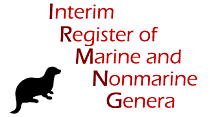
| Intro | | Search taxa | | Taxon tree | | Search literature | | Taxon match | | Homonyms | | Statistics | | Webservice | | Manual | | FAQ | | LifeWatch | | Download | | Log in |
IRMNG taxon detailsThectardis Clapham, Narbonne, Gehling, Greentree & Anderson, 2004 †
marine,
fossil only
Clapham, M. E.; Narbonne, G. M.; Gehling, J. G.; Greentree, C.; Anderson, M. M. (2004). Thectardis avalonensis: a new Ediacaran fossil from the Mistaken Point biota, Newfoundland. <em>Journal of Paleontology.</em> 78(6): 1031-1036., available online at https://doi.org/10.1666/0022-3360(2004)078<1031:taanef>2.0.co;2 [details]
Taxonomic remark Listed as Vendobionta (Charniomorpha) in Retallack, 2016 and as a putative sponge in other sources, however according to...
Taxonomic remark Listed as Vendobionta (Charniomorpha) in Retallack, 2016 and as a putative sponge in other sources, however according to Botting & Muir, 2018, there is "no evidence" of any Poriferan affinity. Antcliffe et al., 2014 suggest that Thectardis could possibly be "highly effaced remnant of some other Edicaran organism representing a stage of extreme decay, where nearly all body morphology is gone and all that remains are microbial mats veiling the smoothed carcass." [details]
IRMNG (2024). Thectardis Clapham, Narbonne, Gehling, Greentree & Anderson, 2004 †. Accessed at: https://irmng.org/aphia.php?p=taxdetails&id=1035088 on 2025-05-31
Date action by
original description
Clapham, M. E.; Narbonne, G. M.; Gehling, J. G.; Greentree, C.; Anderson, M. M. (2004). Thectardis avalonensis: a new Ediacaran fossil from the Mistaken Point biota, Newfoundland. <em>Journal of Paleontology.</em> 78(6): 1031-1036., available online at https://doi.org/10.1666/0022-3360(2004)078<1031:taanef>2.0.co;2 [details]
basis of record Clapham, M. E.; Narbonne, G. M.; Gehling, J. G.; Greentree, C.; Anderson, M. M. (2004). Thectardis avalonensis: a new Ediacaran fossil from the Mistaken Point biota, Newfoundland. <em>Journal of Paleontology.</em> 78(6): 1031-1036., available online at https://doi.org/10.1666/0022-3360(2004)078<1031:taanef>2.0.co;2 [details] basis of record Brands, S. J. (compiler). (1989-2005). Systema Naturae 2000. Amsterdam, The Netherlands (2006 version). Originally available online at http://sn2000.taxonomy.nl/; for current information, refer http://taxonomicon.taxonomy.nl/ProjectDescription.aspx . [details] additional source Retallack, G. J. (2016). Ediacaran fossils in thin-section. <em>Alcheringa: An Australasian Journal of Palaeontology.</em> 40(4): 583-600., available online at https://doi.org/10.1080/03115518.2016.1159412 note: as Vendobionta (Charniomorpha) [details] additional source Erwin, D. H.; Laflamme, M.; Tweedt, S. M.; Sperling, E. A.; Pisani, D.; Peterson, K. J. (2011). The Cambrian conundrum: early divergence and later ecological success in the early history of animals. <em>Science.</em> 334(6059): 1091-1097., available online at https://doi.org/10.1126/science.1206375 note: as fossil sponge, however see note [details] additional source Antcliffe, J. B.; Callow, R. H. T.; Brasier, M. D. (2014). Giving the early fossil record of sponges a squeeze. <em>Biological Reviews.</em> 89(4): 972-1004., available online at https://doi.org/10.1111/brv.12090 note: not a sponge according to these authors [details] verified source for family Botting, J. P.; Muir, L. A. (2018). Early sponge evolution: a review and phylogenetic framework. <em>Palaeoworld.</em> 27(1): 1-29., available online at https://doi.org/10.1016/j.palwor.2017.07.001 note: refer note [details] name verified source Clapham, M. E.; Narbonne, G. M.; Gehling, J. G.; Greentree, C.; Anderson, M. M. (2004). Thectardis avalonensis: a new Ediacaran fossil from the Mistaken Point biota, Newfoundland. <em>Journal of Paleontology.</em> 78(6): 1031-1036., available online at https://doi.org/10.1666/0022-3360(2004)078<1031:taanef>2.0.co;2 [details] current name source Retallack, G. J. (2016). Ediacaran fossils in thin-section. <em>Alcheringa: An Australasian Journal of Palaeontology.</em> 40(4): 583-600., available online at https://doi.org/10.1080/03115518.2016.1159412 [details] extant flag source Clapham, M. E.; Narbonne, G. M.; Gehling, J. G.; Greentree, C.; Anderson, M. M. (2004). Thectardis avalonensis: a new Ediacaran fossil from the Mistaken Point biota, Newfoundland. <em>Journal of Paleontology.</em> 78(6): 1031-1036., available online at https://doi.org/10.1666/0022-3360(2004)078<1031:taanef>2.0.co;2 [details] habitat flag source Clapham, M. E.; Narbonne, G. M.; Gehling, J. G.; Greentree, C.; Anderson, M. M. (2004). Thectardis avalonensis: a new Ediacaran fossil from the Mistaken Point biota, Newfoundland. <em>Journal of Paleontology.</em> 78(6): 1031-1036., available online at https://doi.org/10.1666/0022-3360(2004)078<1031:taanef>2.0.co;2 [details] Unreviewed
Descriptive info Fossil according to SN2000 [details]Taxonomic remark Listed as Vendobionta (Charniomorpha) in Retallack, 2016 and as a putative sponge in other sources, however according to Botting & Muir, 2018, there is "no evidence" of any Poriferan affinity. Antcliffe et al., 2014 suggest that Thectardis could possibly be "highly effaced remnant of some other Edicaran organism representing a stage of extreme decay, where nearly all body morphology is gone and all that remains are microbial mats veiling the smoothed carcass." [details] |